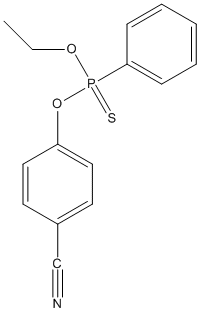Cyanofenphos
Cyanofenphos is a compound of the phenyl phosphonothioate type on the market showing delayed neuropathy together with Leptophos and EPN.Inhibits NTE (neurotoxic esterase)
General
Type : Organophosphate,NTE inhibitor,Cyanide,Not A\/B H target,Sulfur Compound
Chemical_Nomenclature : 4-[ethoxy(phenyl)phosphinothioyl]oxybenzonitrile
Canonical SMILES : CCOP(=S)(C1=CC=CC=C1)OC2=CC=C(C=C2)C#N
InChI : InChI=1S\/C15H14NO2PS\/c1-2-17-19(20,15-6-4-3-5-7-15)18-14-10-8-13(12-16)9-11-14\/h3-11H,2H2,1H3
InChIKey : LRNJHZNPJSPMGK-UHFFFAOYSA-N
Other name(s) : Cyanophenphos,Surecide,Stauffer B-10094,Monsanto CP-19699,Upjohn U-32714
MW : 303.31
Formula : C15H14NO2PS
CAS_number : 13067-93-1
PubChem : 25669
UniChem : LRNJHZNPJSPMGK-UHFFFAOYSA-N
IUPHAR :
Wikipedia :

Target
References (8)
| Title : In vivo inhibition of chicken brain acetylcholinesterase and neurotoxic esterase in relation to the delayed neurotoxicity of leptophos and cyanofenphos - Soliman_1986_J.Environ.Pathol.Toxicol.Oncol_7_211 |
| Author(s) : Soliman SA , Curley A , Farmer J , Novak R |
| Ref : J Environ Pathol Toxicol Oncol , 7 :211 , 1986 |
| Abstract : Soliman_1986_J.Environ.Pathol.Toxicol.Oncol_7_211 |
| ESTHER : Soliman_1986_J.Environ.Pathol.Toxicol.Oncol_7_211 |
| PubMedSearch : Soliman_1986_J.Environ.Pathol.Toxicol.Oncol_7_211 |
| PubMedID: 2432215 |
| Title : Delayed neurotoxicity in the wild mallard duckling caused by the organophosphorus insecticides cyanofenphos and leptophos - Soliman_1986_J.Environ.Sci.Health.B_21_401 |
| Author(s) : Soliman SA , Ahmed NS , el-Gendy KS , el-Bakary AS , El-Sebae AH |
| Ref : J Environ Sci Health B , 21 :401 , 1986 |
| Abstract : Soliman_1986_J.Environ.Sci.Health.B_21_401 |
| ESTHER : Soliman_1986_J.Environ.Sci.Health.B_21_401 |
| PubMedSearch : Soliman_1986_J.Environ.Sci.Health.B_21_401 |
| PubMedID: 2430007 |
| Title : Protective effect of pretreatment against the acute toxicity of formulated cyanofenphos in hens - Konno_1984_Tohoku.J.Exp.Med_142_155 |
| Author(s) : Konno N , Yamauchi T , Yamaguchi Y , Fukushima M |
| Ref : Tohoku J Exp Med , 142 :155 , 1984 |
| Abstract : Konno_1984_Tohoku.J.Exp.Med_142_155 |
| ESTHER : Konno_1984_Tohoku.J.Exp.Med_142_155 |
| PubMedSearch : Konno_1984_Tohoku.J.Exp.Med_142_155 |
| PubMedID: 6719451 |
| Title : [Intensifying effect of repeated pretreatment for delayed neurotoxicity from organophosphorus insecticide cyanofenphos in hens] - |
| Author(s) : Yamauchi T , Konno N , Yamaguchi Y , Fukushima M |
| Ref : Nihon Eiseigaku Zasshi , 39 :611 , 1984 |
| PubMedID: 6521033 |
| Title : Protective effect of pretreatment against the anticholinesterase action of cyanofenphos - |
| Author(s) : Konno N , Yamauchi T , Yamaguchi Y , Fukushima M |
| Ref : Developments in Toxicology & Environmental Sciences , 11 :503 , 1983 |
| PubMedID: 6677495 |
| Title : Comparison of the delayed neurotoxicity of O-methyl and O-ethyl analogs of EPN, leptophos, and cyanofenphos - Francis_1982_J.Environ.Sci.Health.B_17_611 |
| Author(s) : Francis BM , Hansen LG , Metcalf RA , Metcalf RL |
| Ref : J Environ Sci Health B , 17 :611 , 1982 |
| Abstract : Francis_1982_J.Environ.Sci.Health.B_17_611 |
| ESTHER : Francis_1982_J.Environ.Sci.Health.B_17_611 |
| PubMedSearch : Francis_1982_J.Environ.Sci.Health.B_17_611 |
| PubMedID: 7166625 |
| Title : Delayed neurotoxicity of Cyanofenphos in chickens - El-Sebae_1980_J.Environ.Sci.Health.B_15_267 |
| Author(s) : El-Sebae AH , Othman MA , Hammam SM , Tantawy G , Soliman SA |
| Ref : J Environ Sci Health B , 15 :267 , 1980 |
| Abstract : El-Sebae_1980_J.Environ.Sci.Health.B_15_267 |
| ESTHER : El-Sebae_1980_J.Environ.Sci.Health.B_15_267 |
| PubMedSearch : El-Sebae_1980_J.Environ.Sci.Health.B_15_267 |
| PubMedID: 7381187 |
| Title : Delayed neuropathy in sheep by the phosphonothioate insecticide cyanofenphos - El-Sebae_1979_J.Environ.Sci.Health.B_14_247 |
| Author(s) : El-Sebae AH , Soliman SA , Ahmed NS |
| Ref : J Environ Sci Health B , 14 :247 , 1979 |
| Abstract : El-Sebae_1979_J.Environ.Sci.Health.B_14_247 |
| ESTHER : El-Sebae_1979_J.Environ.Sci.Health.B_14_247 |
| PubMedSearch : El-Sebae_1979_J.Environ.Sci.Health.B_14_247 |
| PubMedID: 438464 |